Asbestos legacy: The families fighting for compensation
- Published
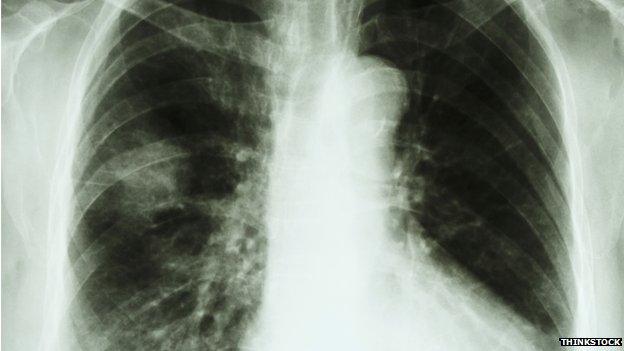
Many consider asbestos to be an uncomfortable relic of industrial history - but families across the UK continue to live with its legacy. Thousands are still being diagnosed with asbestos-related illnesses every year. For many of them, it is just the beginning of a long fight for compensation.
Mary Campbell, 76, is far from the stereotype of someone with terminal cancer - jovial and positive, she punctuates her story with hearty laughter.
"I've got it, it's not going to go away, and I'm not going to let it dictate my life," she says. "I'm determined, put it that way. Or stubborn."
Two years ago, she was diagnosed with mesothelioma, an aggressive form of incurable lung cancer almost always caused by asbestos exposure. She describes herself as feeling "absolutely gobsmacked".
She is one of a growing group of women diagnosed with the disease. Mary's ex-husband was an electrician in Ninewells, where asbestos was commonly used. Every day she used to wash his overalls after work.
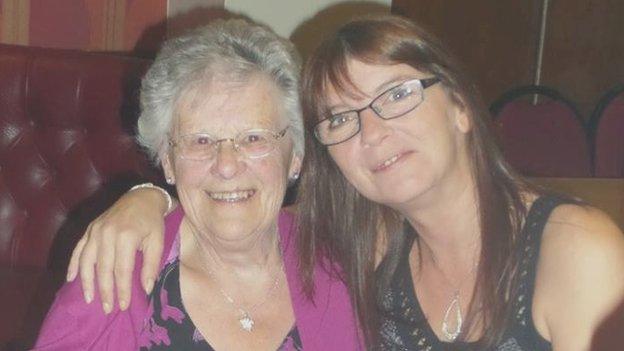
Mary Campbell, left, came into contact with asbestos while washing her husband's work overalls
Mary successfully claimed compensation for herself and her family through the civil courts, arguing this secondary exposure caused her mesothelioma.
The case was settled before the court date on the condition the compensation was awarded sooner rather than later - but not before the defence tried to call both her son and her own solicitor to testify against her.
When Mary talks about this, her tone changes.
"I don't think they realise what they put people through when they do things like that. Not just the person that's got the cancer, but the family… they go through hell. It made me really quite angry."
But Mary describes herself, first and foremost, as fortunate. Her case took two years, but she knows people who have had to wait much longer and faced many more hurdles.
Mary received a six-figure sum between herself and her family. "Other people are not quite so lucky," she acknowledges.
Miracle to murder
Asbestos - once hailed as a "miracle" substance by the construction industry - was used for insulation and fireproofing for most of the 20th Century.
Though the dangers of asbestos were first noted by ancient Greeks and Romans, who noticed that it damaged the lungs of slaves who wove it into cloth, it was 1969 before the first UK asbestos regulations came in. And it was 2006 before The Control of Asbestos Regulations brought together all previous sets of regulations to cover the prohibition of the substance.
Asbestos is now the single greatest cause of work-related deaths in the UK. About 5,000 workers a year, external - including 20 tradesmen every week - are dying because of previous exposure to asbestos.
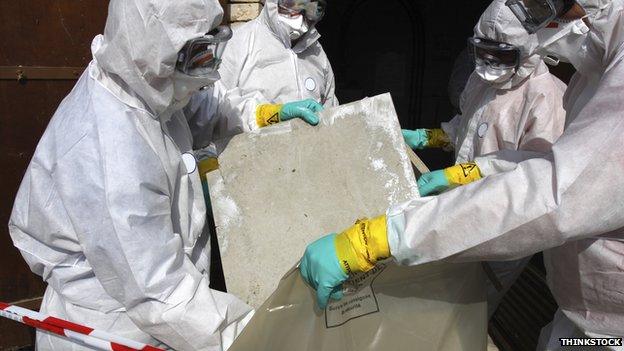
When disturbed, asbestos fibres are inhaled, which is how they damage the lungs
The effects are showing no signs of slowing. The most recent figures, external from the Health and Safety Executive predict UK cases of mesothelioma will not start to decline until 2020.
Mesothelioma is not the only disease caused by asbestos. Asbestos-induced lung cancer kills nearly as many people every year. Prolonged exposure to asbestos can cause asbestosis, a chronic lung condition caused by scarring of the lungs.
And workers are still being diagnosed with pleural plaques and diffuse pleural thickening - two more lung conditions associated with asbestos exposure.
More than money
It takes years for these diseases to start showing symptoms, which is why mesothelioma cases are only just beginning to peak - and why many lawyers are seeing a steady rise in the number of clients seeking compensation.
But for individuals told they have only months left to live or families who have watched their relatives die in pain, compensation is about more than money.
The reasons for claiming vary from person to person, says Fraser Simpson, head of the Industrial Disease Department at Digby Brown Solicitors.
"Partly there is a quest for justice… for others it's simply a sense of trying to achieve some security, not so much for themselves but for their families."
The long latency periods associated with these diseases can cause problems. People have to remember details about work they did 40 years before in order to prove negligence of an employer.
For families seeking compensation after the death of a relative, it becomes even harder. How many people know what their father did on a daily basis at work, nearly half a century ago?

Asbestos can be found in various forms in any building constructed before the year 2000
The difficulties don't end there. Successful claims made through civil law are usually paid for by insurers - but in many cases, these details are hard to track down.
"In the vast majority of cases, the insurance would have been there," says Fraser Simpson. "But the problem is if the employer's no longer there, sometimes it's very difficult to trace which insurer provided that cover."
For those who cannot trace an insurer, there are other options, external. This year, the government introduced a new scheme for people diagnosed with mesothelioma after July 2012 who cannot trace their employer or insurer. Payments from this scheme are made from a pot of money contributed to by insurers - but compensation claims are 80% what they might have been if the claim had been made through the civil courts.
The Department for Work and Pensions makes payments for people diagnosed with asbestos-related illnesses after being exposed to asbestos in the workplace.
Many still choose to pursue claims through the courts, because if an employer or insurer can be identified the compensation can be higher.
Generations of pain
Frances Hamilton died of mesothelioma in 2014 - the same disease that killed her mother 28 years before.
Frances did not live to see the end of a case she started against her former employers.
She said she was 15 when she started helping her mother at work - at a company called Wrights Insulation, based on a Glasgow industrial estate - where she worked on-and-off, filling in for several days a week. She was paid cash-in-hand.
"It was extremely dusty work," said Frances in her legal statement. "I distinctly remember my arms and hands being itchy with the sharp fibres caused from the asbestos being in my skin."
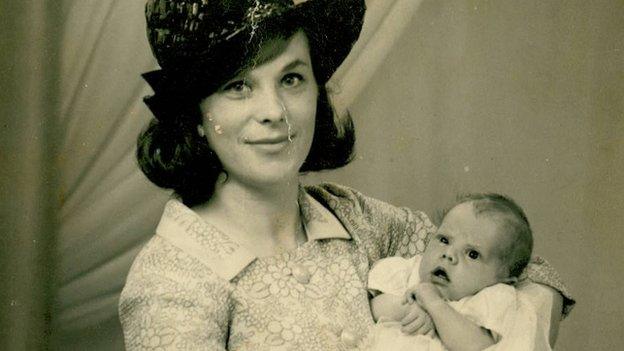
Frances Hamilton died of mesothelioma before she was able to claim compensation. Her family are continuing her fight
Frances said her mother, Lizzie McLellan, worked on boiler covers for steam locomotive engines, and that Lizzie had to sew "huge asbestos mats" together.
Frances Hamilton's family have not been able to claim compensation for the loss of their mother. Her casual work - which lasted nearly a decade - does not show up in her HM Revenue employment history.
Now her lawyers, Irwin Mitchell Solicitors, are appealing for witnesses - people who can testify to Frances's work at the company. Without this proof, Frances' family will never gain compensation from the civil courts.
Wrights Insulation Ltd has long ceased trading. The lawyer responsible for the firm's defence told the BBC it was only listed on the register to deal with historic asbestos claims.
Charlie Glass's family are also struggling with the effects of asbestos.
He spent his working life as an electrician in Glasgow. Over the past five years, he has watched his friends and family fall ill from asbestos-related illnesses - his cousin George, a plasterer, and brother Tommy died. Another cousin, a plumber, is ill. A friend who he worked with for 40 years was diagnosed with pleural plaque last year.
Doctors told Charlie he had pleural plaques two and a half years ago - six months after the death of his brother from mesothelioma. Charlie describes his death as "terrible".
He is now seeking compensation - something he could only do in Scotland or Northern Ireland. Those diagnosed with pleural plaques in England and Wales are not eligible to claim.
For Charlie, the reasons are not just financial. Until his diagnosis, he had never heard of pleural plaques - since, he has watched one friend after another be diagnosed. He wants to raise awareness of the condition, and of asbestos-related illnesses in general.
"There's a hell of a lot of people who've died…
"I think their families are all due something. Especially when the government knew about this years ago."
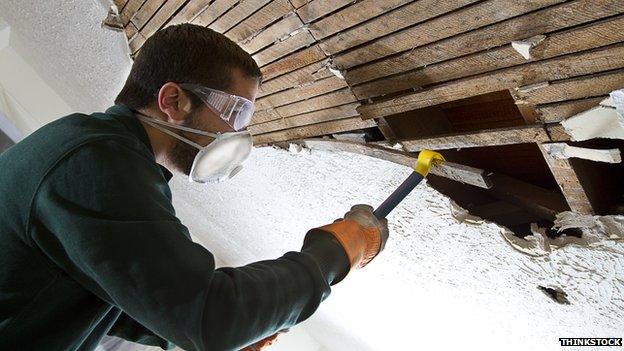
Disturbed asbestos poses a threat to people who inhale fibres as they carry out DIY
Modern threats
Dr Robert Rintoul, a consultant respiratory physician at Papworth Hospital, has seen a change in patients with asbestos-related illnesses.
Asbestosis is usually caused by heavy exposure and develops after 10 or 20 years. New cases of the disease are relatively rare, as most of those diagnosed have now died.
The UK has the highest incidence per head of the disease than any other country in the world.
"The cases we're seeing now are mainly patients with mesothelioma," says Dr Rintoul. "In general the exposure levels required to develop mesothelioma are much lower than with asbestosis."
Any building constructed before 2000 could contain asbestos - and many do, in corrugated roofs, floor and ceiling tiles, insulation around pipe work, and elsewhere. Asbestos left undisturbed is not harmful - but anyone carrying out home improvements is potentially at risk.
"There is concern we may see a second wave of people in years to come with mesothelioma who have developed it due to unwittingly exposing themselves to asbestos during DIY," says Dr Rintoul. "We could avoid these cases in the future if we raise awareness now of the risks of old asbestos."
Dr Rintoul explains there are more and more cases where the cause of the exposure is less obvious - which could make life even harder for those claiming compensation in future, especially through the civil courts.
Until diagnosis, people could spend 50 years unaware of what lies ahead.
"It really is quite frightening," says Mary Campbell, "to think that there's so many people out there that could be affected by mesothelioma and they don't know it."